 |
 |
Books |
| Resources | Reviews M-Z |
 |
 |
Books |
| Resources | Reviews M-Z |
McMenanin, MAS (1998), The Garden of Ediacara: Discovering the First Complex Life. Columbia Univ. Press, 295 pp. ISBN 0-231-10558-4
 This book both chronicles the author’s search for Ediacaran fossils and attempts to interpret the biota and its significance to evolutionary biology. McMenamin recounts his searches in Mexico, Namibia, and Australia, and includes a few drawings and photographs of specimens and the locales in which they were collected.
This book both chronicles the author’s search for Ediacaran fossils and attempts to interpret the biota and its significance to evolutionary biology. McMenamin recounts his searches in Mexico, Namibia, and Australia, and includes a few drawings and photographs of specimens and the locales in which they were collected.
There is some interesting information here, but to get to it though, you have to wade through a lot of personal anecdotes in tedious detail and other interjections of minimal relevance. On the Amazon site, an equally frustrated "reader from Boise, Idaho," concludes:
‘I have read the book nearly twice and each time close it with a deep sense of disappointment. The problem I have with the story is the personal observation and biographical material. I wanted to read about Ediacaran animals not the Namibian airport, recalcitrant gatekeepers and inane diary entries about who the author had dinner with. Some of the book could have been taken up with more photos and perhaps professional sketches [rather than] crayon drawings from Mrs. Thompson’s second grade class.
‘The ideas the author presents on the fauna are what made me get through the book at all. Those were great but occupy very little of the book.’
A similar criticism is logged by professional paleontologist, Ben Waggoner (Department of Biology, University of Central Arkansas): "Scientists and laymen alike will be turned off by the book’s jagged organization, stylistic weaknesses, constant horn-blowing, and endless speculation." (Waggoner's full review here.)
|
This book features far too much author. In my experience, most scientists are a modest lot but, unfortunately, some of their popularist representatives seem to have an ego the size of all outdoors, and this guy is clearly one of them. However, ego is not the book's foremost defect: There are two other, and rather more serious, shortcomings.
The first is one of veracity. Waggoner again: "[A] serious flaw is the relatively small number of photos of the Ediacaran fossils. Most of its illustrations are fairly simple, unshaded line drawings, which aren’t always accurate – I know that Bomakellia doesn’t have the ornamented glabella-like thingamajig that figure 5.7 illustrates. A book that purports to solve the Mystery of Ediacaran Life really ought to include more photographs, camera lucida drawings, and professional-quality reconstructions of the specimens...." The diagram Waggoner refers to is minimalist – almost child-like in its simplicity. The lines drawn on the boss at the top of the figure cannot be misinterpreted for shading or anything else: So, if they are not present on the original specimen, what can we believe except that McMenamin is making it up? On page 35 (reference to note 67) McMenamin refers to the Middle Cambrian arthropod "Marella" as "a true soft-bodied trilobite." Indeed? In fact, Marrella (with two 'r's) is neither soft-bodied, nor a trilobite.
Second, McMenamin presents extraordinary interpretations based upon – as far as I can see – no evidence at all, let alone the very strong evidence normally expected when advancing any radical idea [® sidebar]. As another Amazon commentator opined, the author advances hypotheses without any "real scientific test of these ideas" relying instead upon "over extended analogies and conjecture." Quite so. For example, McMenamin concludes – on the basis of what evidence eludes me – that although they were related to animals, Ediacarans were not animals in the strict sense, because they never passed through an embryonic blastula stage (which is peculiar to animal life forms, as far as we know). He believes they developed a central nervous system and a brain independent from animal evolution. Well, I guess that's fine but, for all the evidence McMenamin provides, he might equally well have suggested they beamed down from Mars.
Recommendation: If you ignore the unsubstantiated conjecture, and have the patience to battle your way through the author’s I said..., I did..., I am..., then McMenamin’s book contains a few interesting snippets for anyone interested in the Ediacaran biota: Half a star.
A better read is Chapter 3 of "Major Events in the History of Life" (J. William Schopf ed.) in which Bruce Runnegar writes about the fossils (rather than about Bruce Runnegar).
Look and Feel: Hardback; good paper; indifferent line drawings; good resolution b&w photographs; variable colour plates (and, of 18 plates, only five depict fossils! Plate 1 illustrates McMenamin’s Mexican identity card, plate 4 depicts a packet of Lithops seeds....)
© Chris Clowes 2001
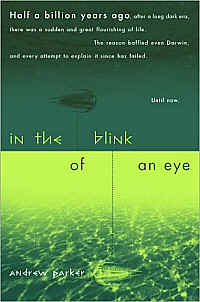 Parker,
Andrew (2003), In the Blink of an Eye
. Perseus Publishing, 316
pp. ISBN 0-7382-0607-5
Parker,
Andrew (2003), In the Blink of an Eye
. Perseus Publishing, 316
pp. ISBN 0-7382-0607-5
To be fair, this is not the kind of book I like. These sorts of popularizations are often the elevator music of science: banal, dumbed down, and deliberately designed as distractions from the real business of the reader's day. Often, they are also what I'm always afraid Palæos will turn into: a sort of self-absorbed, "Look how smart I am!" technoblog, full of monomanias and crackpot analysis. The world is full of smart people with ideas. Most of these ideas are, inevitablty, completely daft. A reasonable percentage of the people who have them write competently, as Parker certainly does. That is not reason enough to write a book or -- for that matter -- to put up a gigantic web site. So reviewing these books also makes me nervous, because I'm not sure exactly who should be casting the first stone at whom. Accordingly, I've read it twice. I'm glad I did. The book is much better than it seems on first reading.
Make no mistake. Parker's idea is daft. He believes that the Cambrian explosion was driven by the development of vision in several animal groups, particularly the trilobites. Read the book critically, and you'll see why he's wrong. On the other hand, this is the kind of book one can read critically. Parker lays out his evidence and thought process carefully and non-technically. He doesn't spend much space talking about himself, or waste the reader's time with personalities. His paleontology is not completely up to date, but he's not a paleontologist. He's a zoologist and vision physiologist. More importantly, his method is impressive, even if he ultimately gets the wrong result. His work exemplifies what we all must do, more and more: follow the truth of an idea wherever it may lead, without regard to traditional academic and scientific borders. His willingness to explore the paleontological evidence, as well as ideas from other disciplines, is what makes the book worth reading. More science ought to be done this way.
While it is hard to accept Parker's specific conclusions, his general concept is worth some thought as well. For example, one could make a very strong case that the Triassic "explosion" of new tetrapod forms was associated with the independent acquisition, in at least four separate lineages, of acute, pitch-sensitive hearing. In each case, the engineering innovation involved very similar anatomical changes. We need not leap to the conclusion that advanced hearing caused the faunal turnover of the Triassic. Manifestly, it did not. But Parker's book validly teaches us that that matters of this type are worth a much closer look.
Other reviews: In the Blink of an Eye (relatively uninformative reviews), Bookslut- In the Blink of an Eye by Andrew Parker; In the Blink of an Eye - www.smh.com.au; Parker, Andrew- In the Blink of an Eye; American Scientist Online - On the First Day, God Said . . . (Conway Morris doesn't like it much); In the Blink of an Eye. Andrew Parker. Review. (excellent, detailed review). ATW040101.
Vertebrate Life by F. Harvey Pough, Christine M. Janis, John B. Heiser - basic level textbook, a very good and readable overview of vertebrate physiology, evolution, etc. Technical concepts all well explained
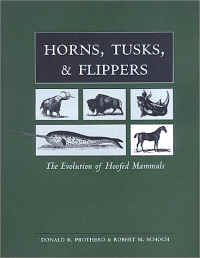 Prothero, Donald R & RM Schoch
(2002), Horns, Tusks, and Flippers: The Evolution of Hoofed Mammals. Johns Hopkins Univ. Press., 311 pp. ISBN
0-8018-7135-2
Prothero, Donald R & RM Schoch
(2002), Horns, Tusks, and Flippers: The Evolution of Hoofed Mammals. Johns Hopkins Univ. Press., 311 pp. ISBN
0-8018-7135-2
I wanted a book which surveyed the ungulates. This book does that. I wanted one with literature references. It has them. I wanted a book with a phylogenetic perspective, sampling extinct, as well as living groups. Yes, it has that, too. I even wanted a book with lots of brontotheres, just because I happen to like them. It has a whole chapter on brontotheres. So why am I not satisfied?
First, let's be clear about the verdict. This is a good book. If you want something with ungulates, references, evolution, and, of course, brontotheres, by all means purchase the book. The investment will be a wise one, and the book will probably remain a useful reference for a decade or two -- well past the shelf life of most things that live on shelves. The book is solid, if about five years out of date on some phylogenetic matters, clearly written, and remarkably comprehensive for so short a book on so large a topic.
But therein lies the rub. This is a truly fantastic and exciting topic. The ungulates are as unique and successful among mammals as dinosaurs are among reptiles. The Cenozoic is sometimes called the Age of Mammals. It might more aptly be called the Age of Rodents and Ungulates. The rest of us hairy folk have only bit parts in a story starring these two great therian clades.
However, Horns, Tusks, & Flippers is not fantastic or exciting. Its more like a set of course notes for a good, solid, if slightly stodgy, course at a liberal arts college, retooled for the interested general reader. Perhaps that's what it is. The difficulty is that a book, unlike a course, has to have thematic content. Zoology 205, Evolution of the Ungulates, must have at least a paragraph on every last tiresome deer family because Zoology 205 is a survey course. A book for the general reader doesn't have to do that, and shouldn't. What it must have is an explanation of why we should care. The usual technique, and the one which works the best, is simply for the author to tell us the reasons why he cares.
Prothero and Schoch sometimes hint at those reasons. For example, no matter how diverse the ungulates, the terrestrial forms generally fall into certain specific guilds, with very similar body plans. In Holocene terms, these are the horse, antelope, giraffe, hippo, elephant, pig, camel, and ox types. I've probably missed a few, and doubled up on others. These keep reappearing, and lineages tend to split along these lines. However, not all the jobs are always filled. There were no "hippo" types in North America between the Oligocene and the Middle Miocene. Today, we're short on a sort of small grazer niche that ungulates have often filled. What about the converse? Is the collection of known ungulate guilds a complete description of herbivore ecospace? In other words, are there herbivore jobs out there that are never filled by ungulates? How has any of this changed over time and phylospace?
The trouble is that one has to extract these meaty issues from stacked bales of naturalistic fodder. The questions are not asked, much less answered, in the book. A central theme of that type (and there are many others in this remarkable area) would do much to turn this good and solid book into a compelling read. A bit more anatomy wouldn't hurt; but, for a chapter on brontotheres, I will forgive much.
So, read the book for what it is. Even if it is not quite all it could be, it's a worthy volume.
ATW040221
Romer, Alfred S (1956), Osteology of the Reptiles . 1997 reprint ed. Krieger Publ. Co., 772 pp. ISBN 0-89464-985-X
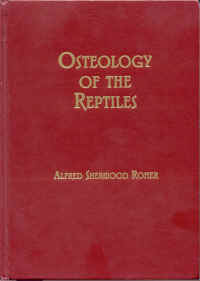 This is the 1997 reprint edition of Romer's 1956 treatise. The style is
hopelessly dated. The phylogeny is so obsolete as to be, at times,
incomprehensible. There are no references to speak of. The
illustrations, for an anatomy reference, are few and crude. Yet, this book
is indispensable. No one who is serious about Mesozoic vertebrate
paleontology keeps this book far beyond arm's reach. Although it is 50
years old, no one has even tried to update or edit Romer's text. Some have
added glosses or exegesis, like Vedic commentaries. The text itself is
inviolate, and simply part of the received wisdom of the profession.
This is the 1997 reprint edition of Romer's 1956 treatise. The style is
hopelessly dated. The phylogeny is so obsolete as to be, at times,
incomprehensible. There are no references to speak of. The
illustrations, for an anatomy reference, are few and crude. Yet, this book
is indispensable. No one who is serious about Mesozoic vertebrate
paleontology keeps this book far beyond arm's reach. Although it is 50
years old, no one has even tried to update or edit Romer's text. Some have
added glosses or exegesis, like Vedic commentaries. The text itself is
inviolate, and simply part of the received wisdom of the profession.
The Osteology is not just an anatomy text. In fact, as an anatomy text, it is not that complete. No one, even Romer, could really cover this topic in one volume, and certainly not at the level of anatomical detail at which things are done today. However, this book is still the voice of perhaps the most influential vertebrate anatomist of the last century, writing at the height of his powers. So, the Osteology is not really a complete text. It is best understood as a comprehensive distillation of anatomical ideas -- many original to Romer -- which are still the conceptual background against which almost all subsequent work has been done.
It is difficult to convey to someone who has not done much anatomy exactly what, and how much, this means. Some examples may help: (a) the idea that the humerus should be analyzed as having 4 triangular sides, (b) the idea that Sphenodon and basal amniotes (that's right, even our own Bob is due to Romer) should be used as two important reference points for reptile anatomy, (c) the way in which embryonic germ layers are used to understand homology among vertebrate groups, (d) the concept that muscle actions can be analyzed in terms of the basic dorsoventral organization of trunk muscles in fish; and (e) our fundamental understanding of the relationships between locomotion and limb posture -- in fact the whole approach which was taken towards structure-function relationships until very recently.
The last two examples raise a different issue. Inevitably, there is some dead weight after 50 years. For example, the recent work of locomotion anatomists like Gatesy, Blob and Hutchinson rests squarely on the foundation of structural concepts embodied in Romer's Osteology. However, their work also suggests that Romer's approach to muscle action was not only inadequate, but perhaps headed us off in the wrong direction. The modern mode of analysis differs qualitatively from Romer's dorsoventral patterning. Instead, the analysis is essentially radial. Each major joint is treated as a hub, and one works in a circle around that hub, identifying the muscle actions which are effective over various portions of its range of motion. Romer stresses embryology and focuses on position. The current view emphasizes mechanics and focuses on kinetics. Even so, the Osteology is the baseline from which the newer understanding departed, and it would be difficult to appreciate the importance of what the current lot of locomotion anatomists are doing without a clear appreciation of their point of departure.
It would be pointless for us to "recommend" this book. One does not recommend a copy of the tax code to an accountant. Either she already has a copy, or she is not an accountant. When you have reached a certain point in your studies, you, likewise, will find that you have already acquired this book. ATW031223.
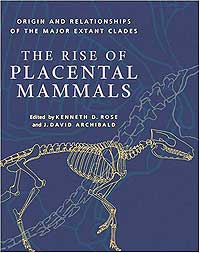 Rose,
Kenneth D & J David Archibald [eds.] (2005), The Rise of Placental
Mammals: Origins and Relationships of the Major Extant Clades. Johns
Hopkins University Press, 259 pp.
Rose,
Kenneth D & J David Archibald [eds.] (2005), The Rise of Placental
Mammals: Origins and Relationships of the Major Extant Clades. Johns
Hopkins University Press, 259 pp.
We apologize in advance for a short and hurried review. Difficult as it is to conceive, this rather pricey ($95.00) volume is probably worth the money. Rose and Archibald must surely have someone on the payroll who leaves the skulls of (formerly) extant mammals where, as in the famous horse head scene in The Godfather, they send an unmistakable message to contributing authors. At any rate, Rose and Archibald have succeeded in getting a large number of busy and well-known paleomammal folks to toe the line in remarkable fashion, producing 15 chapters of high and level quality. The content is not formulaic, but each of the 11 chapters devoted to particular clades covers the same essential topics relating to its allotted taxon, including both molecular and morphological evidence with a fairly even hand.
But wait! There's more! The best news is that the focus of the book is largely on developments above the level of the traditional mammalian orders. Thus, there is extensive discussion of Altungulata, Euarchonta, Afrotheria, and others that are frequently mentioned, but rarely discussed. Its a pity that a separate chapter was not devoted to Afrotheria -- although, admittedly, we don't personally believe that this is a clade. Nevertheless, there's plenty of discussion at various different points in the extensive text. Don't let the seemingly paltry page count fool you. The pages are large. The print size is small. The text is dense. As usual with JHU Press, the illustrations are relatively few and of low quality. However, the real point is the cladograms, which fortunately don't demand too much of this publisher.
If you are a regular reader of Palaeos, you may well question the viability of our occasional anti-molecular rants by the time you finish the book. (Actually, you may well question the viability of any of our opinion pieces, whether or not you read this book). We have resolved to be less strident in future. Molecules have come a long way in a very short time. The naive studies that placed rabbits as the closest relatives of mankind have generally been succeeded by far more sophisticated stuff that now often makes sense. Frankly, we still do not understand why phylogenetics doesn't take the obvious step of treating molecules as morphological entities, not just sequences of amino acids or nucleotides [1]. This step is very slowly being taken by a few molecular types, who are realizing the enormous value of rare genetic events. These are still being dealt with as sequence issues, largely insertions and deletions. Perhaps good tertiary structure information is still too sparse for broad scale phylogenetic studies. However, it would not be too surprising to see molecules and morphology merge in the next 10-20 years.
One serious methodological disappointment may be found in the chapter by Robert Asher on Insectivora. Asher attempts to combine molecular and morphological data using Bayesian methods. This ought to work. It has to work. But it hasn't worked so far. Asher recovers a tree rooted in a paraphyletic rodent group, the infamous man/rabbit relationship, and other unlikely combinations. However, its early days yet for this complicated technique.
Altogether, an excellent book. ATW050713.
[1] C.f. Carroll (2005), a well-argued review by Sean Carroll, a molecule guy, who has a related complaint about the field's inexplicable obsession with sequence over function.
 Vickers Rich, P, TH Rich, MA Fenton, & CL
Fenton (1997), The Fossil Book : A Record of Prehistoric Life.
Dover Publ., 760 pp. ISBN: 0486293718
Vickers Rich, P, TH Rich, MA Fenton, & CL
Fenton (1997), The Fossil Book : A Record of Prehistoric Life.
Dover Publ., 760 pp. ISBN: 0486293718
I only have the original (1958) edition by Fenton and Fenton. Sorta folksy style, but very readable. A good introduction to the various invertebrate groups, plants, fish and land animals from Earth's past. Includes a number of Paleozoic species. It may be out of date but still covers topics (e.g. plants, invertebrates) many other books ignore. MAK.
Links: The Fossil Book - A Record of Prehistoric Life (customer reviews -- and one anti-Creationist rant); ? Reviews for Rich,_Thomas_Hewitt. But seriously, who needs a review of a book which has been a continuously updated classic for almost half a century?
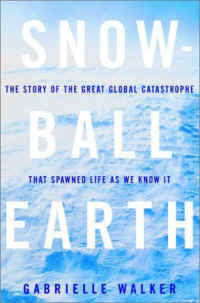 Walker,
Gabrielle (2003), Snowball Earth
. Crown Group: 269 pp.
ISBN 0-7475-6433-7.
Walker,
Gabrielle (2003), Snowball Earth
. Crown Group: 269 pp.
ISBN 0-7475-6433-7.
When I first picked up Snowball Earth, I thought I’d somehow gotten hold of a large print copy or something: the text is huge and widely spaced. Although this format makes it particularly easy for somebody in their dotage, like me, to read the thing, it also spins the book out to a somewhat misleading 269 pages. There simply isn’t that much content in here.
Sadly, that was only the first of several disappointments awaiting me between the covers. Perhaps most irritating, the book is constructed like a work of fiction. Points of interest are introduced only with the greatest circumspection. Of this there is no better example than the Preface: Six pages of gassing with nothing - nothing - relevant to the topic. Paul Hoffman used to be a marathon runner. Ok, fine; now let’s get on with it. Then on to chapter one and another four-and-a-half pages of waffle between “Shark Bay” and the first occurrence of the word “stromatolite.”
Worse is to follow: Almost as soon as this first point of interest finally is made, the chapter ends and we’re off talking about something else! The entire narrative flip-flops back and forth between ideas, apparently deliberately, as if attempting to build suspense. It made me think of Tolkein’s The Two Towers, in which the author employs the same technique, though rather more proficiently, and with the happy advantage of doing so for a reason. No sooner are we actually given some morsel of information to think about, than we are whisked off to elsewhere and elsewhen. Frankly, it’s all completely tedious and, worse than that, it makes the book impossible to use as a reference. Because there is no logical structure to it, you can’t find anything unless there is an (obvious) index entry to exactly what you are looking for.
|
As for the science itself, this book is extremely superficial. Not only that, but the instant we’re off the main topic, the science becomes pretty suspect, also. Some statements, such as “there were no worms in the Precambrian” (p. 116), or that the bizarre progeny of the ‘Cambrian Explosion’ date “from the beginning of the Cambrian period, around 545 million years ago” (p. 203), are simply incorrect. But more often Walker’s pronouncements are not exactly wrong, factually; they’re just distinctly misleading. For example, p. 159 claims that paleomagnetic polarity reversals occur “roughly once every few hundred thousand years” which is only true for some periods of the planet’s history and conspicuously ignores the Cretaceous “quiet periods” when the polarity appears to have remained constant for millions of years. An even better example is the non sequitur “By finding [paleomagnetic] reversals in the Flinders ice rocks, Linda confirmed Joe’s discovery that ice had been present near the equator” (p. 160). Oh, yes; we’re all on first name terms here. The final few nails in the coffin are the several references - at least one rather florid - to the dinosaurs being wiped out by an asteroid. (Yes, a bolide of some sort almost certainly did strike the Earth at the end of the Cretaceous. Did it wipe out the dinosaurs? Sorry to ruin a good story, but nobody knows to what extent it may have contributed to their demise. Taking a broader view of mass extinction events throughout the Phanerozoic, volcanism alone shows a good correlation with observed extinctions - read more.)
The unfortunate conclusion is that Walker simply doesn’t know her stuff.
To judge from the descriptions of interviews and excursions, a great number of eminent and busy scientists gave a great deal of their time to the author and authoring of this ... novel. It is hard to imagine they’d be willing to do it again, even for a more accomplished practitioner, which is perhaps the saddest indictment of this effort. Even weighted up against some undoubted public-educational benefit, it seems to me this effort will have done more harm than good, in the long term.
Recommendation: Barely recommended; strictly for a light read, and only if you’re feeling particularly indulgent. Otherwise I’d have to say it’s crap.
Look and Feel: My edition is the usual matt-finish paperback. There are no photographs, though some would have been beneficial. There are good index and references sections.
Chris Clowes 0305xx
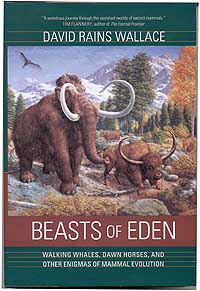 Wallace,
David R. (2004), Beasts of Eden: Walking Whales, Dawn Horses, and Other Enigmas of Mammal Evolution
. U. Calif. Press, 340 pp.
Wallace,
David R. (2004), Beasts of Eden: Walking Whales, Dawn Horses, and Other Enigmas of Mammal Evolution
. U. Calif. Press, 340 pp.
The title of this book is more or less unrelated to its content. The book is a brief and anecdotal history of mammal paleontology by someone who doesn't seem to care much for paleontologists. Almost everyone comes off looking like a lazy, self-absorbed, megalomaniac -- except living paleontologists. Wallace even finds mean-spirited things to say about Simpson, which isn't easy.
The book is not completely useless, because the history of mammalian paleontology is an interesting subject, and there are few other sources. Wallace also writes reasonably well -- although his heart just doesn't seem to be in the subject matter of this book. Wallace is primarily known as a naturalist and conservationist. I understand that some of his books in that area are considered among the best of their kind. However, he has little ability as either historian or paleontologist.
His history is a history of individuals. As we go back further in time in this history, these individuals seem more and more like two-dimensional caricatures who behave in sundry irrational and amusing ways. That's usually a sign that the writer is not making a serious attempt to understand a person or an era on its own terms. Rather, he has subsumed the real person into a modern stereotype, or simply accepted myth as history. That's perhaps a bit unfair. Wallace briefly discusses aspects of Darwin and Huxley, for example, which were interesting and certainly new to me. However, almost everyone comes off as selfish and conceited in their later careers. Racial senescence, no doubt ...
Wallace does have one genuine theme worthy of the history of ideas -- sort of. Unfortunately, he never really tells us what it is. It appears that he sees paleontology as constantly in tension between the proponents of Darwinian selection and those favoring some sort of teleological development. The problem is that this model, and Wallace's discussion, breaks down after the early Twentieth Century. Since 1950, most of the challenges to natural selection as the principal engine of evolution have come from the other side: the radical indeterminism of Gould's punctuated equilibrium, the proponents of random genetic drift as the prime mover, studies of apparently pathological sexual selection (e.g. the peacock). These critiques of natural selection are quite the opposite of teleological. Their fundamental criticism of Darwinian natural selection is that things are more random and unpredictable than can be accounted for by gradual, incremental, selection for fitness.
There isn't a great deal of science in the book. Wallace deals very competently with the "Modern synthesis" and some other "big" ideas. He gets into trouble, sometimes very serious trouble, over the details. For example, this wonderful pronouncement from p. 230: "It is less well known that, when modern grazers were evolving, many grasses underwent a major biochemical shift, metabolizing a different carbon isotope, C4, than most plants, which use the isotope C3." How did this get past the editor? Almost every word is wrong. C4 plants use the same carbon isotopes as every other plant. However the initial carbon fixation step in photosynthesis differs. In C3 plants, carbon dioxide is added to form a three-carbon carboxylic acid. In C4 plants, it forms a four-carbon carboxylate. Because of the differing chemistry, there is a tiny difference in the relative rates at which the naturally occurring carbon isotopes 13C and 12C are incorporated, and thus a corresponding difference in the isotopic composition of the plant material remaining in fossils. This so-called δ13C value can be used to determine whether the predominant vegetation was C4 or C3. C4 plants evolved many times independently, probably beginning in the Oligocene. However, they were relatively rare until the very end of the Miocene. The same dry, highly seasonal conditions which drove the evolution of modern grazers at that time also favored C4 grasses. [1]
It's fairly hard to talk about mammal paleontology without at least touching on the intricacies of molar cusp patterns, the energetics of warm-blooded animals, the wonderful interplay of jaw, ear and brain, and a host of similar subjects. These, like C4 grasses, are sometimes tough and dry, but ultimately well worth adapting to. This book doesn't cover any of these matters. On the whole, we'd encourage you to graze elsewhere. ATW040518.
[1] Our explanation may also have its flaws, but we don't charge you $25+ for our errors.
Whittington, HB, BDE Chatterton, SE Speyer, RA Fortey, RM Owens, WT Chang, WT Dean, PA Jell, JR Laurie, AR Palmer, LN Repina, AWA Rushton, JH Shergold, ENK Clarkson, NV Wilmot, & SRA Kelly (1997), Treatise on Invertebrate Paleontology, Part O (Revised) Arthropoda 1, vol. 1: Trilobita: Introduction, Order Agnostida, Order Redlichiida. RA Kaesler [ed.]. Geol. Soc. Amer. & Univ. Kan., 530+ pp.
ISBN 0-8137-3115-1
At last, volume one of the long-awaited update to Moore's 1959 epic. It is difficult to understand the monumental amount of work in one of these volumes of the Treatise without reading through it. Take the chapter on ontogeny, for example. How do we know how a trilobite developed? After all, we can hardly watch one. Only by collecting dozens or hundreds of fossils of each – at first, no doubt, misidentified as different species – and comparing them, across collection, institution, and probably national boundaries: work which may take multiple workers decades. The 530 pages of this volume represents whole lifetimes of dedicated research.
The Treatise is a technical reference for professional palaeontologists so you will want to be a very enthusiastic amateur before you consider buying it. If you are, though, then this is definitely the definitive word on trilobite morphology, habit, ontogeny, evolution and classification available today. It is not a complete systematic review of the whole class, however: This is the first volume of a work which is expected to stretch to three. Systematic descriptions are given for the Agnostida and Redlichiida only.
Readers familiar with the 1959 version will first notice that the familiar line drawings have been almost totally replaced by excellent (at least 600 dpi) photographs of actual fossils. As before, taxonomic descriptions are provided down to generic level, providing authorship, synonymy, diagnostic morphology, type species and provenance.
Recommendation: Recommended.
Look and Feel: Hardcover textbook.
© Chris Clowes
Zimmer, Carl (1998), At the Water's Edge: Fish with Fingers, Whales with Legs, and How they Came Ashore, but Then Went Back to Sea. Free Press, 290 pp. ISBN 0-684-83490-1.
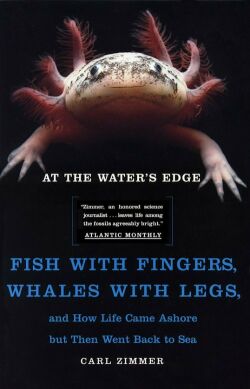
Like most of these lay audience type books, it is all wrapped up with the usual annoying human interest stories about the careers of some of the more notable scientists working in the particular field, and the usual titillating hints about professional rivalries which, in my experience, simply don’t exist (or at least no more than in ordinary life). That said, the book is accessible, well-written and informative: Recommended.
Links: CarlZimmer.com; Review of At the Water's Edge by Carl Zimmer; The Politburo Forum - Mini-Review- "At the Water's Edge"; IW Books - At the Water's Edge; Everybody Out of the Pool (review by Philip Gingerich).
© Chris Clowes
checked ATW031218